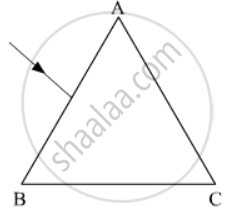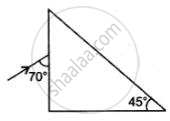Advertisements
Advertisements
प्रश्न
A light ray does not bend at the boundary in passing from one medium to the other medium if the angle of incident is ______.
पर्याय
0°
45°
60°
90°
उत्तर
A light ray does not bend at the boundary in passing from one medium to the other medium if the angle of incident is 0°.
APPEARS IN
संबंधित प्रश्न
The figure shows a ray of light falling normally on the face AB of an equilateral glass prism having refractive index`3/2`, placed in water of refractive index `4/3`.Will this ray suffer total internal reflection on striking the face AC? Justify your answer.

Draw the diagram of a right-angled isosceles prism which is used to make an invented image erect
Name two factors which affect the critical angle for a given pair of media. State how do the factors affect it.
State two advantages of using a right-angle prism as a reflector, rather than a plane mirror.
Images formed by totally reflecting prisms are brighter than the image formed by ordinary reflected light, why?
State one factor on which a critical angle for a given pair of media depends. The critical angle for the glass-air interface is 45° for the yellow light. Will it be equal to, less than or greater than 45° for (i) red light, (ii) blue light?
What is meant by the statement, ‘the critical angle for diamond is 24°’?
Complete the following diagram to show the path of the ray of a single colour in the diagram as if enters in and emerges out of the prism. Mark the angles wherever necessary. (Critical angle for glass = 42°).

The resultant `vec"R"` of `vec"P"` and `vec"Q"` is perpendicular to `vec"P"`. Also `|vec"P"|=|vec"R"|`. The angle between `vec"P"` and `vec"Q"` is ______.
[tan 45° = 1]
